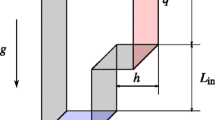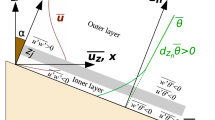Abstract
The base pressure pb, for an initial turbulent boundary layer, is determined for supersonic nonisothermal flow about a two-dimensional backward-facing step. This problem has been considered previously. In solving it in [1, 2], use was made of the Korst condition [3], which assumes equality of the total pressure pj * on the line of constant mass to the pressure behind the closing oblique shock. However the pressure at the reattachment section p* is lower than that behind the closing shock by 30–40% [4], and consequently the Korst condition is inaccurate. Therefore in the references cited only qualitative agreement with experiment was obtained. In contrast with [1, 3], Nash [5] introduces p*; however, it is defined by an empirical coefficient. In the present study, to find pb we make use of the condition of conservation of mass in the base region, written in the form of the equality pj *=p*, where p* is defined from the assumption of minimum thickness δ of the dissipative layer at the reattachment section.
Satisfactory agreement with the available experimental data is obtained without the use of correction factors. In the simplest case, when the thickness of the oncoming boundary layer δ1=0, the proposed method is no more complex than that of Korst. The determination of the base pressure with δ1=0 is considered in §1, and the determination with δ1>0 is considered in §2.
Similar content being viewed by others
References
R. K. Tagirov, “Determination of base pressure and base temperature for the sudden expansion of sonic or supersonic flows,” Izv, AN SSSR, OTN, Mekhanika i mashinostroenie, no. 5, 1961.
E. N. Bondarev, “Approximate estimate of the effect of a turbulent boundary layer on base pressure,” Izv. AN SSSR, OTN, Mekhanika i mashinostroenie, no. 3, 1964.
H. H. Korst, “A theory for base pressures in transonic and supersonic flow,” J. Appl. Mech., vol. 23, no. 4, 1956.
M. Sirieix, “Pression de culot et processus de mélange turbulent en écoulement supersonique plan,” Rech. Aéronaut., no. 78, 1960.
J. F. Nash, “An analysis of two-dimensional turbulent base flow, including the effect of the approaching boundary layer,” A.R.C.R.M., no. 3344, 1963.
L. Crocco and L. Lees, “A mixing theory for the interaction between dissipative flows and nearly isentropic streams,” J. Aero. Sci., vol. 19, no. 10, 1952.
D. W. Holder and G. E. Gadd, “The interaction between shock waves and boundary layers and its relation to base pressure in supersonic flow, Boundary layer effects in aerodynamics,” Proc. Symposium held at the National Physical Laboratory, London, 1955.
J. F. Nash, “A review of research on two-dimensional base flow,” A.R.C.R.M., no. 3323, 1962.
R. K. Tagirov, “Calculation of thermal flux for two different supersonic flows past a backward-facing step,” Izv. AN SSSR, OTN, Mekhanika i mashinostroenie, no. 6, 1963.
G. N. Abramovich, Theory of Turbulent Jets [in Russian], Fizmatgiz, 1960.
M. A. Badrinarayanan, “An experimental investigation of base flows at supersonic speeds,” J. Roy. Aeronaut, Soc., vol. 65, no. 607, 1964.
Author information
Authors and Affiliations
Rights and permissions
About this article
Cite this article
Tagirov, R.K. Influence of the initial boundary layer on base pressure. Fluid Dyn 1, 99–101 (1966). https://doi.org/10.1007/BF01013830
Issue Date:
DOI: https://doi.org/10.1007/BF01013830




